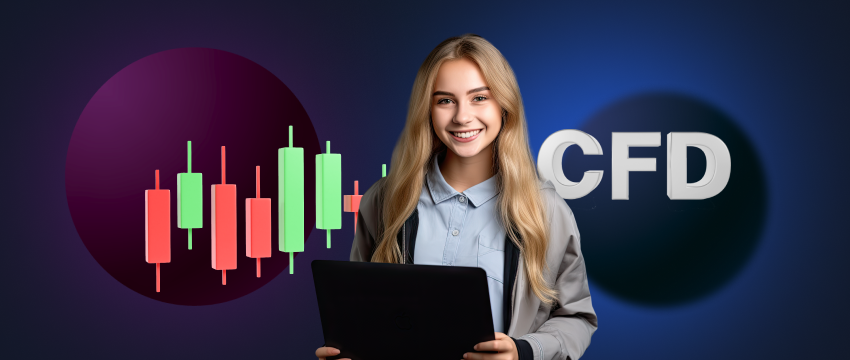In the fast-paced world of financial trading, “CFD trading” has become a buzzword that piques the interest of many aspiring investors. But what exactly is CFD trading, and how can it serve as a gateway to the expansive universe of financial markets? This guide aims to demystify CFD trading for beginners, offering a comprehensive overview that will equip you with the foundational knowledge needed to explore this intriguing investment avenue.
CFD trading, or Contract for Difference trading, allows traders to speculate on the price movements of various financial instruments without owning the underlying assets. This versatility makes it an appealing option for those looking to diversify their trading portfolios. By the end of this guide, you’ll understand the nuts and bolts of CFD trading, its potential benefits, and the risks you need to consider before taking the plunge.
Understanding the Basics of CFD Trading
The world of CFD trading can initially seem overwhelming, but grasping the basics can provide a solid foundation for further exploration. At its core, a CFD is a financial contract between a trader and a broker. The agreement involves exchanging the difference in the price of an asset from the time the contract is opened to when it is closed.
CFDs are available on a variety of financial instruments, including stocks, commodities, indices, and currencies. This range enables traders to access global markets and react swiftly to economic events. Unlike traditional asset trading, CFDs allow you to profit from both rising and falling markets by buying (going long) or selling (going short). This flexibility can be advantageous for traders seeking to maximize opportunities in volatile markets.
Benefits of CFD Trading for Beginners
For those new to trading, CFDs offer several appealing features. One of the primary advantages is the ability to trade with flexible leverage. This means you can control a larger position with a smaller initial investment, potentially amplifying your profits. However, it’s crucial to remember that leverage can also increase losses, so it’s essential to manage risk carefully.
Another benefit of CFD trading is access to a wide array of markets. Traders can explore various sectors and asset classes without needing to open multiple accounts or platforms. This convenience makes it easier for beginners to diversify their portfolios and gain exposure to global financial markets.
Additionally, CFD trading platforms often provide educational resources and tools to help novices understand market dynamics and develop their trading skills. These resources can be invaluable in building confidence and competence as you begin your trading journey.
Navigating Risks in CFD Trading
While CFD trading offers numerous opportunities, it’s important to be aware of the risks involved. The use of leverage can magnify both gains and losses, making risk management a critical aspect of successful trading. Beginners should familiarize themselves with stop-loss orders and other risk mitigation strategies to protect their investments.
Market volatility is another factor to consider. Prices can fluctuate rapidly, leading to potential losses if positions are not carefully monitored. Staying informed about economic news and events can help traders anticipate market movements and make more informed decisions.
Lastly, it’s essential to choose a reputable broker with a user-friendly platform and transparent fee structure. Take the time to research different brokers, read reviews, and understand their services to ensure a positive trading experience.
Essential Strategies for Beginner CFD Traders
Developing a solid trading strategy is key to succeeding in CFD trading. For beginners, starting with a simple and consistent approach can help build discipline and understanding. One popular strategy is trend following, where traders identify and capitalize on market trends by entering positions in the direction of the trend.
Another strategy is range trading, which involves identifying support and resistance levels within which an asset’s price fluctuates. Traders buy near support levels and sell near resistance levels to profit from price movements within the range.
Risk management should be an integral part of any trading strategy. Setting stop-loss and take-profit levels can help mitigate potential losses and lock in profits. It’s also beneficial to diversify your CFD portfolio across different asset classes and sectors to spread risk.
The Role of Technology in CFD Trading
Technology plays a significant role in modern CFD trading, providing traders with powerful tools to analyze markets and execute trades efficiently. Most brokers offer advanced trading platforms equipped with charting tools, technical indicators, and real-time data feeds. These tools enable traders to make informed decisions and respond quickly to market changes.
Mobile trading apps have also become increasingly popular, allowing traders to access their accounts and monitor positions on the go. This flexibility is especially beneficial for those with busy schedules who want to stay connected to the markets.
Additionally, algorithmic trading and automated trading systems are becoming more accessible to retail traders. These systems use algorithms to execute trades based on predefined criteria, removing emotional bias and potentially improving consistency in trading performance.
CFDs vs. Other Trading Instruments
Understanding how CFDs compare to other trading instruments can help beginners make informed decisions about their trading activities. Unlike traditional stock trading, CFDs allow traders to speculate on price movements without owning the underlying asset. This ability to go long or short provides greater flexibility in responding to market conditions.
Compared to options trading, CFDs generally have lower complexity and no expiration dates, making them more accessible for beginners. Options require a deeper understanding of various strategies and can involve complex pricing structures.
Futures contracts are another alternative to CFDs but typically require larger capital outlays and involve higher risk. CFDs, on the other hand, offer the advantage of trading with flexible leverage, enabling traders to control larger positions with a smaller initial investment.
Building Your CFD Trading Skills
Like any skill, successful CFD trading requires practice and continuous learning. Begin by familiarizing yourself with the basic concepts and gradually explore more advanced strategies as you gain confidence. Many brokers offer demo accounts that allow you to practice trading with virtual money, providing a risk-free environment to hone your skills.
Stay informed about market developments and economic trends by following financial news outlets and online trading communities. Engaging with fellow traders can also provide valuable insights and support as you progress in your trading journey.
It’s also beneficial to review your trading performance regularly. Analyzing past trades can help identify strengths and weaknesses, enabling continuous improvement and refinement of your trading approach.





